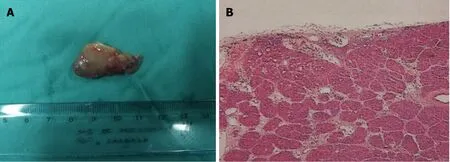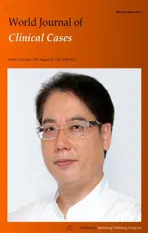Acute pancreatitis connected with hypercalcemia crisis in hyperparathyroidism:A case report
2019-03-14YiBoMaJunHuYunFeiDuan
Yi-Bo Ma, Jun Hu, Yun-Fei Duan
Abstract
Key words: Acute pancreatitis; Hypercalcemia; Hyperparathyroidism; Case report
INTRODUCTION
Primary hyperparathyroidism (PHPT) is commonly characterized as an endocrine disorder with hypercalcemia attributable to overexpression of parathyroid hormone(PTH) from one or more parathyroid glands[1].The occurrence of hypercalcemia crisis is usually associated with an elevation of PTH.Hypercalcemia in patients with PHPT can result in various comorbidities such as gastrointestinal symptoms, electrolyte disturbance, renal dysfunction, acute pancreatitis, or can be asymptomatic[2-5].Hypercalcemia with acute pancreatitis as an initial symptom is an uncommon presentation of PHPT and its prevalence is estimated to be between 1.5% and 7%[6,7].Upon routine laboratory testing, PHPT may be diagnosed incidentally as hypercalcemia can be asymptomatic in a large number of patients.
The regulation of serum calcium in humans mainly depends on the secretion of PTH.The normal serum levels of calcium range from 2.25 to 2.75 mmol/L.Multiorgan clinical manifestations can occur due to excessive serum calcium.However,acute pancreatitis as the first clinical presentation in PHPT is rare.Hypercalcemia caused by undiagnosed PHPT may be the only causative factor in acute pancreatitis[8].Therefore, this disease is often misdiagnosed or overlooked completely during clinical consultation.We report a case of hypercalcemia-induced acute edematous pancreatitis as the first manifestation of a benign parathyroid adenoma in a male patient.This man was diagnosed with PHPT and subsequently underwent parathyroidectomy with complete resolution of all symptoms.
CASE PRESENTATION
Chief complaints
A 57-year-old man presented to the emergency room with sudden onset of severe epigastric pain with nausea and vomiting for less than one day.
北京市《关于进一步加强本市孤儿保障工作的意见》中提出,“多方扶持促进孤儿成年后就业。人力资源和社会保障部门要鼓励和帮扶有劳动能力和就业愿望的孤儿成年后实现就业,将其作为就业援助的重点对象,纳入本地区再就业工作规划。孤儿成年后失业并进行失业登记后,参加职业培训并就业的,按有关规定,给予职业培训补贴、职业技能鉴定补贴,并免费提供职业介绍和职业指导等服务。要优先安排符合就业困难条件的孤儿到政府开发的公益性岗位就业;对就业困难孤儿自谋职业、自主创业的,给予社会保险补贴。鼓励用人单位吸纳孤儿就业,对吸纳符合就业困难条件孤儿的用人单位,给予岗位补贴、社会保险补贴。”
History of present illness
The patient’s initial symptoms consisted of sudden onset of severe epigastric pain,nausea, and vomiting.His consciousness was unaffected.The pain did not radiate along his back and was without paroxysmal exacerbation.He denied chill, fever,cough, and expectoration.
History of past illness
He had no history of essential hypertension, diabetes mellitus, or relevant cerebrovascular disease.There was no previous history of gastrointestinal disease or biliary system symptoms.He had no history of smoking or alcohol consumption.
Physical examination upon admission
His temperature, blood pressure, heart rate, and respiratory rate were all normal on admission.There was mild upper abdominal tenderness, rebound tenderness, and no apparent muscle tension in physical examination.
Laboratory examinations
After admission, the patient completed a series of laboratory examinations.Blood tests revealed the following inflammation markers:White blood cell count, 26.71 ×109/L (4-10 × 109/L)(94.9% neutrophils); C-reactive protein, 35.5 mg/L (0-10 mg/L);hemoglobin, 152.0 g/L; platelet count, 433 × 109/L; glutamic-pyruvic transaminase, 15µ/L; glutamic-oxalacetic transaminase, 13 µ/L; alkaline phosphatase, 121 µ/L; urea,8.48 mmol/L; and creatinine, 127.0 µmol/L.The representative diagnostic markers of pancreatitis were as follows:serum amylase 1091 µ/L; serum sodium, 152.2 mmol/L;serum potassium, 4.01 mmol/L; serum calcium, 4.67 mmol/L; and serum PTH level,95.8 pmol/L.
Imaging examinations
B-mode ultrasound showed mild fatty liver and no obvious gallbladder or pancreas abnormalities.Electronic gastroscopy revealed esophagitis, chronic superficial gastritis with bile reflux and duodenal bulb inflammation.Electrocardiography and contrast echocardiography showed no special heart symptoms.Computed tomography and magnetic resonance imaging of the abdomen revealed pancreatic tail contusion, exudative changes around the pancreas, and double kidney stones.Gallstones or correlative biliary system diseases were not observed (Figure 1).
Further diagnostic work-up
In order to confirm the diagnosis, thyroid ultrasound was undertaken in this patient.It showed bilateral thyroid nodules on the right neck mass originating from the inferior thyroid gland or parathyroid (Figure 2).
FINAL DIAGNOSIS
On the basis of biochemical parameters combined with his clinical manifestations, the patient was diagnosed with acute pancreatitis, hypercalcemia, and PHPT.
TREATMENT
During the first two days, the patient was treated with hydration consisting of 2 L isotonic saline every day, diuresis with the intravenous loop diuretic furosemide at 20 mg every 8 h, and small doses of glucocorticoids each day for depression of serum calcium concentration.However, the concentration of serum calcium was still maintained at a high level.Due to the high risk of cardiovascular and cerebrovascular disorders and deterioration of acute pancreatitis, following discussion with the patient and his relatives, he subsequently accepted parathyroid exploration and right parathyroidectomy.During surgery, the volume of the bilateral thyroid was normal.A 3.0 cm × 2.0 cm hyperplastic parathyroid mass on the inferior aspect of the right thyroid lobe was excised.After operation, the patient was admitted to the intensive care unit and treated with fasting, water deprivation, continuous gastrointestinal decompression, gastric acid suppression, inhibition of pancreatic secretion, fluid replacement, nutritional support, and anti-infectious agents.
OUTCOME AND FOLLOW-UP
In the postoperative period, the levels of serum PTH and calcium decreased slowly(Figure 3), and the patient gradually recovered over the next two weeks.Histopathological examination confirmed the diagnosis of right parathyroid adenoma(Figure 4).The patient was discharged with regular follow-up for six months.
DISCUSSION
PHPT is now a common endocrine disorder caused by the inappropriate overproduction of PTH secreted by an overactive parathyroid gland[9].Compared with young individuals, postmenopausal women over the age of 50 years have a greater probability of developing PHPT[10].The most common pathogenesis of PHPT is parathyroid gland adenomas (80%-85%), and rare causes include parathyroid hyperplasia, carcinoma, multiple endocrine neoplasia type 1 and 2A, and parathyroid cysts[11].Most patients with PHPT have mild symptoms or are asymptomatic.Despite the variety of PHPT clinical manifestations, hypercalcemia is the most common condition in most clinical cases[12].
Hypercalcemia is a common and potentially fatal metabolic disorder that is most often attributable to PHPT or malignancy-associated disease[13].An elevation in PTH is one of the principal factors in the initiation of hypercalcemia.Excessive accumulation of serum calcium and decompensation of the renal system promote the development of hypercalcemia.Initially, the symptoms of hypercalcemia are mild or are not notable at the time of discovery.However, the developing symptoms that characterize a crisis are mental disturbance, metabolic encephalopathy, renal insufficiency,gastrointestinal symptoms, and cardiac dysrhythmia[14].Early diagnosis and preoperative medical management are crucial, and surgical intervention is the optimal treatment for a hypercalcemic crisis.
Acute pancreatitis is an inflammatory process, which has sudden onset due to the premature activation of proteolytic zymogens within the exocrine pancreas[15].It can be severe with extensive morbidity and mortality[16].The majority of cases of acute pancreatitis are caused by chronic alcohol consumption and biliary stones.The most frequent cause of acute pancreatitis is gallstone pancreatitis.Biliary stones induced pancreatitis is caused by duct obstruction by gallstone migration leading to temporary impaction of migrating stones at the duodenal ampulla, increased duct pressure, and unregulated stimulation of the digestive enzymes secreted by the pancreas.The second most common cause of acute pancreatitis is alcoholic pancreatitis.Alcohol may sensitize the pancreas to damage by external and environmental factors.The development and recurrence of acute pancreatitis are positively associated with chronic alcohol consumption.
Acute pancreatitis is an uncommon clinical manifestation of PHPT and the prevalence of PHPT-associated pancreatitis in patients were just 1%-8%[17].The association between PHPT and acute pancreatitis has been debated for decades.Hypercalcemia may play a crucial role in this association and directly affect the severity and prognosis of the disease.Three mechanisms are involved in the development of PHPT-induced acute pancreatitis.One is PHPT-induced high serum calcium level, which can lead to acceleration of the conversion of trypsinogen to trypsin in the pancreas resulting in pancreatic autodigestion and subsequent acute pancreatitis[18].Secondly, the accumulation of calcium can promote the formation of ductal obstruction, pancreatic calculi, and subsequent attacks of acute pancreatitis[19].Thirdly, genetic variants in serine protease inhibitor Kazal type 1 and cystic fibrosis transmembrane conductance regulator genes in combination with hypercalcemia markedly increase the risk of developing acute pancreatitis in patients with PHPT[20].
The level of serum calcium is the key to early diagnosis, estimating disease severity,and treatment.When patients with acute pancreatitis are found to have no obvious causes and elevated serum calcium is observed, PHPT-induced pancreatitis should be suspected.The treatment of hypercalcemia includes hydration with saline, forced diuresis, bisphosphonates, calcitonin, oral phosphates, glucocorticoids, and dialysis.But surgical resection is still the most effective treatment.Parathyroidectomy may not only relieve the abdominal symptoms of acute pancreatitis but also prevent the recurrence of hypercalcemia.However, a severe parathyroid crisis caused by a parathyroid adenoma can lead to a series of secondary clinical manifestations,including gastrointestinal symptoms, electrolyte disturbance, renal dysfunction, and acute pancreatitis.
In our case, renal function reflected by creatinine and urea nitrogen increased, to some extent, before and after surgery.Therefore, we used continuous renal replacement therapy to maintain stable renal function.Continuous renal replacement therapy is a method of renal support that has the potential to avoid the development of electrolyte disturbance and deterioration of renal function.Renal replacement therapy was essential for controlling symptomatic hypercalcemia until medical therapy restored renal function and enhanced renal excretion of calcium.Therefore,PHPT-associated acute pancreatitis should be detected early and appropriate early treatment initiated.Establishing good cooperation between various hospital departments is also critical in treating this rare phenomenon of acute pancreatitis caused by PHPT-induced hypercalcemia.
CONCLUSION
The clinical features of PHPT-induced acute pancreatitis are nonspecific; thus, the diagnosis can be challenging.However, we should exclude patients with acute pancreatitis caused by chronic alcohol consumption and biliary stones before the diagnosis of PHPT-induced acute pancreatitis.Although the disease has a relatively good prognosis, complete surgical resection remains the optimal, safe and curative treatment option available.Early recognition and early-targeted treatment may be the best way to tackle the corresponding diseases.

Figure 3 Changes of the concentration of parathyroid hormone and Ca2+.

Figure 4 Resected specimen showed a 3.0 cm × 2.0 cm hyperplastic material parathyroid mass after excision (A) and histopathology:right parathyroid adenoma (B).Magnification, x 100.
猜你喜欢
杂志排行
World Journal of Clinical Cases的其它文章
- Malignant syphilis accompanied with neurosyphilis in a malnourished patient:A case report
- Ex vivo revascularization of renal artery aneurysms in a patient with solitary kidney:A case report
- Pseudothrombus deposition accompanied with minimal change nephrotic syndrome and chronic kidney disease in a patient with Waldenström's macroglobulinemia:A case report
- Hepatocellular carcinoma successfully treated with ALPPS and apatinib:A case report
- Treatment of invasive fungal disease:A case report
- Ulcerative colitis complicated with colonic necrosis, septic shock and venous thromboembolism:A case report
